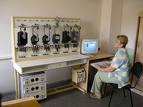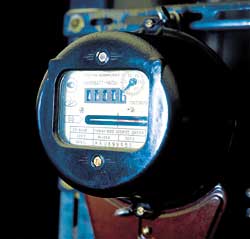Causes of disturbance of electricity measurement and malfunction of induction meters
Accounting violations can be caused by the following reasons:
-
non-compliance with the normal operating conditions of the counter;
-
meter malfunction; malfunction of measuring transformers;
-
increased load on instrument transformers;
-
increased voltage drop in voltage circuits;
-
wrong circuit for turning on the glucometer;
-
malfunction of elements of secondary circuits.
Meter failure when normal operating conditions are not observed
Energy measurement errors in case of violation of the correct sequence of phases
When the phase sequence changes, the magnetic note of one rotating element partially falls into the field of the other rotating element. Therefore, in three-phase two-disc meters there is some mutual influence of the rotating elements, the result of which is the dependence of the error on the phase sequence. The counter is adjustable and included in direct rotation.However, after the repair of the power equipment, the phase rotation may change, which causes an increase in the error at low loads (about 1% at a load of 10%).
The change in phase sequence may go unnoticed if the three-phase motors are not included in the electrical receivers.
Energy measurement errors for unbalanced loads
Unbalanced loads have a negligible effect on meter error. A certain increase in error may occur in the absence of a single-phase load, which is practically excluded. The equalization of phase loads is intended not only to reduce losses, but also to increase the accuracy of accounting. A three-element counter is not affected by load imbalance.
Energy measurement errors in the presence of higher current and voltage harmonics
The non-sinusoidal shape of the current is mainly determined by electrical receivers with a non-linear characteristic. These include, in particular, gas discharge lamps, rectifiers, welding devices, etc.
The measurement of electricity in the presence of higher harmonics is carried out with an error, the sign of which can be positive or negative.
With a frequency deviation of 1 Hz, the error of the counter can reach 0.5%. In modern power systems, the nominal frequency is maintained with great accuracy, and the question of frequency influence is irrelevant.
Energy measurement errors with voltage deviations from nominal values
 A significant change in the error of the meter occurs when the voltage deviates from the nominal by more than 10%. Usually the effect of low voltage must be taken into account.When the load of the glucometer is less than 30%, a decrease in voltage causes the error to change in the negative direction due to the weakening of the action of the friction compensator. At loads above 30%, the reduction in voltage leads to a change in the error already in a positive direction. This is due to a reduction in the braking effect of the working flow of the voltage value.
A significant change in the error of the meter occurs when the voltage deviates from the nominal by more than 10%. Usually the effect of low voltage must be taken into account.When the load of the glucometer is less than 30%, a decrease in voltage causes the error to change in the negative direction due to the weakening of the action of the friction compensator. At loads above 30%, the reduction in voltage leads to a change in the error already in a positive direction. This is due to a reduction in the braking effect of the working flow of the voltage value.
Sometimes meters with a nominal voltage of 380/220 V are installed in a network of 220/127 or even 100 V. This cannot be done for the above reasons. Let us recall once again that Rated voltage the counter must match the actual.
Energy measurement errors when load current changes
The load characteristic of the meter depends on the load current. The counter disc starts rotating at a load of 0.5-1%. However, in the load zone up to 5%, the counter is unstable.
In the 5-10% range, the counter operates with a positive error due to overcompensation (the compensating torque exceeds the friction torque). On further increasing the load to 20%, the meter error becomes negative due to the change in the magnetic permeability of the steel at low series winding currents.
 With the smallest error, the meter works in the range from 20 to 100% of the load.
With the smallest error, the meter works in the range from 20 to 100% of the load.
Overloading the counter to 120% results in a negative error due to the effect of disk stalling from running threads. These errors are regulated by GOST. With further overload, the negative error increases sharply.
As for the current transformer error, it depends on the primary load current to a much lesser extent.In practice, one should consider an error in the load range of less than 5-10 and more than 120%.
To correctly estimate the load, it is necessary to remove several daily schedules (on different days of the week and seasons).
Changing the power factor within 0.7-1 does not significantly affect the meter error. Installations with a lower power factor cannot be considered satisfactory. When the ambient temperature changes, in most cases it is necessary to take into account the influence of negative temperatures. At negative temperatures of about -15 ° C, the underestimation of energy can reach 2–3%. The increase in the negative error is mainly due to the change in the magnetic permeability of the brake magnet. At lower temperatures, thickening of grease may occur in meters with bearing lubrication. Then, at a load of less than 50%, the error of the meter will increase sharply.
Effect on counter reading of external magnetic fields
To avoid the influence of external magnetic fields, the glucometer should not be installed near welding machines, powerful wires and other sources of significant magnetic fields.

The influence of the position of the counter on the accuracy of its readings
The position of the meter affects the accuracy of the measurement. The axis of the measuring device must be strictly vertical. A deviation of more than 3 ° introduces an additional error due to a change in the friction moment at the supports. The position of the counter and the plane on which it is installed is checked along three coordinate axes.
Other causes of malfunction of the induction meter
A malfunction of the counter can occur suddenly under the influence of sharply adverse influences. These can include shock and shock, prolonged overload, short circuit during connection, lightning and switching surges.
The meter may also gradually pass into a defective condition before the overhaul period expires. As a result of premature wear caused by unfavorable operating conditions, various defects appear: corrosion of the permanent magnet, electromagnetic wires and other metal parts, clogging of the gaps in which the discs rotate, thickening of the lubricant; loose fastening of parts.
Methods of determining the cause of malfunction of an induction measuring instrument
All malfunctions of measuring instruments usually lead to the following consequences: suspension of the mobile system, overestimated error, incorrect operation of the counting mechanism, self-propelled.
With the disk stationary, check the presence of voltage on all phases at the terminals of the meter and the value of the current in the series windings. A vector diagram is then taken. If all measurements do not reveal the reason, it is due to the malfunction of the glucometer.
If there is a suspicion of a large error of the glucometer, then it is necessary to carry out its control check at the place of installation. The check can be carried out either by a control counter or by means of wattmeters and a stopwatch. Using a reference meter gives greater measurement accuracy.
The use of a wattmeter and a stopwatch to determine the error of the meter is possible only in cases where the load is unchanged during the measurements or changes slightly (± 5%). The load must be at least 10% of the nominal.
A mechanical chronometer and exemplary single-phase wattmeters of class 0.2 or 0.1 or three-phase class 0.2 or 0.5 are required for counter-checking of the meter. Class 0.2 wattmeters can be used to calibrate Class 2 and less accurate meters. In this case, the metrological requirements will be fulfilled. Applying the same wattmeters to calibrate class 1 meters, it is necessary to make corrections, taking into account the error of standard devices. Sometimes two ammeters and two or three voltmeters are also included.
A self-propelled meter results in overestimated readings if the load is absent for certain periods of time. It is possible to check the glucometer for the absence of independent movement by disconnecting the series windings from the previously shorted circuits.
Accounting errors in the case of an incorrect commutation circuit of an induction meter
A faulty meter switching circuit can occur in two cases: if an error was made during the initial check (or no such check was made at all) and if changes were made to the circuit during operation. Therefore, in all cases of accounting violations, the correctness of the inclusion must be checked again.Secondary circuit element faults include open voltage circuit or blown fuse on one phase, open circuit in series circuit. In most cases, malfunctions result in a rotating element being inactive. Faults are easily identified by measuring currents and voltages at the terminals of the meter.
